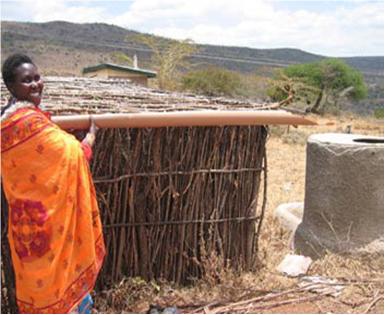Burkina Faso: From water managers to water “beggars”
In a village in northern Burkina Faso, in the Sahel region, a rainwater harvesting (RWH) system for drinking water was installed in a family compound. The system catches rainwater from a sheet-iron roof and diverts it to a tank with a capacity of 10m3. The size of the tank was based on a need for 3 litres/day/person during the hot season (from March-June) when other water sources become scarce. The capacity of the system was determined by the NGO constructing the system, based on technical data (rainfall, water sources, pollution, etc.) and the type of RWH system they wanted to propose to the villagers. This system costs about 600,000 FCFA (EUR 915) of which 10% has to be financed by the beneficiaries. Guaranteeing water quality requires very rigorous management, as the roof and all openings have to been cleaned regularly.
In this case, the tank was placed next to the house of the polygamous head of the family, because his house was the only one with an iron roof. The houses inhabited by his wives have thatched roofs and are therefore unsuitable for collecting water of drinking water quality. Because the tank gathers water from his roof, the husband keeps the key of the tank, which gives him the authority to decide who can get water from the tank.
 |
|---|
| A rather expensive RWH system for pure drinking water |
From water managers to water “beggars”
In discussions, beneficiaries mentioned the following points about their experiences with the RHW system in this project:
- Before the project, women had responsibility for water management in the family. Now they have to ask their husband to give them water from the tank, changing their status from water managers to water “beggars”. They have become dependent on the goodwill of their husband who keeps the key to the tank and himself has free access to the water stock.
- Women explained that access to water is much more difficult during rainy season, when they work in the fields the whole day. When returning home they need water quickly so that they can cook a meal and wash the children. Everybody is hungry and tired, and they themselves are physically exhausted. Everybody in the village wants to use the water sources at the same time, and it is difficult for the women to know there is water in the RHW tank that they can’t use, as it is being kept for the hot season. In fact, in the hot season women actually have more time to fetch water, as there is less other work to do.
- The management and maintenance of the RWH system is too demanding during the rainy season. If dust is blown on the roof before the rain falls, to ensure quality, water should be left running for some time before it can be diverted to the tank. Somebody has to stay home to do this, instead of working in the field. Even so, people don’t trust the water quality because of the long storage period (six months).
|
|
|---|
| A cheap RWH system from a traditional roof. Photo:IRHA-H2O |
Conclusions
Conclusions to be drawn from the case include:
- The needs of the different users should have been taken into account. Only the rich could afford the RWH system as sheet-iron roofs were necessary to maintain water quality. This turned the RWH system into a status symbol, like a car outside the door. It also made the women dependent on the person in charge of the key to the tank. A simpler and cheaper RWH system, adapted to thatched roofs covered with plastic sheets during the rainy season, would have been better tailored to the needs of the women.
- Assumptions about the use of the water and water quality were made without involving the beneficiaries. The assumption that water was needed most during the hot season was incorrect; the need for water from the tanks is just as great in the rainy season.
- No information about the different possibilities of RWH systems and purification methods was given to users beforehand. Only one type of design was presented. If users had been informed beforehand, they could have decided themselves what kind of system would have been the most appropriate. They might have opted for a simple and cheap RWH system which does not provide clean water, combined with a purification system like a cheap ceramic water filter, to get drinking water.
Informing both women and men, rich and poor about the different possibilities of RWH systems and involving them in the decision making about planning, design and management will lead to not only appropriate but also to sustainable RWH systems.



